Seed Bead Sizes and Brands
When you start beading, the different seed bead sizes can be very confusing. Worse than that, it turns out that the same size of seed bead can actually vary a little bit from brand to brand! How does this affect your beadwork and what do you need to know? Well, read on, and I will explain the differences and take a look at why they matter. Then you’ll know which seed bead brands to look for and why.
How do seed bead sizes vary?
Let me begin with a common assumption. When you start beading and someone explains to you that seed beads are available in different sizes, 15, 11, 8, 6 and so on, this seems confusing enough. However, it doesn’t take too long to get your head around the sizing system.
It is natural enough to then assume that all size 11 beads are the same. Unfortunately, as you continue with different projects, you may come to realise that this isn’t the case.
Firstly, you may see different patterns list different brands in their materials list. Like most beginners, I made the error of ignoring the brand and just using the size of bead that I happened to have in stock. Sometimes this is fine, but sometimes I would find that the project just didn’t sit right. I might think it was my fault. Perhaps my tension was wrong, or perhaps I had misunderstood an instruction as all this was new to me.
But my skill may not have been the problem. Some designs will only work properly with a specific brand of seed bead.
Different brands and different sizes
Why is this? You may well ask. The simplest way to explain this is through an illustration. I created a little set of samples to show my students when I’m teaching. I took the leading brands of seed bead and stitched a little sample of Peyote stitch with each brand. Take a look below:
In my actual sample, it is immediately obvious that all five samples are slightly different sizes. Don’t forget, I made them all with size 11 seed beads! Now, you may not see that in the photo, so let me elaborate.
I made each sample with 14 rows of Peyote stitch, with five beads per row. (Count them up if you don’t believe me!). In order to help you really see the difference in the seed bead sizes, I’ve marked the width and height of each little sample.
You will see that the difference is only as small as 1-2mm. But of course, the larger the sample you are beading, the more this tiny difference matters. It is magnified as you work.
How do I know which seed bead brand to buy?
There isn’t a simple answer to that question. But I am going to give you a few simple rules that will help you to avoid beading errors caused by seed bead sizes.
Rule number one
If you are buying seed beads for your own pleasure, then it really doesn’t matter which brand you choose. Buy whichever your local bead shop sells, or whichever has the colours that you like. BUT do scroll on down to check the essential tips about mixing seed bead brands…
Rule number two
If you are buying for a specific project, then make sure you buy the brand that the designer has specified. If you choose to substitute a different brand, then don’t be surprised if you find that the project doesn’t work quite as well as it should.
What if the designer hasn’t specified a brand? In that case, just use your favourite and see what happens.
There are two broad reasons why a designer may not specify a brand. Firstly, it may not matter. But again, scroll on down to read the essential information about mixing brands!
Secondly, the designer may not be very experienced and may not realise that the brand matters (I’ve been there!). Or maybe they don’t even know which brand they used. Some bead sellers are better than others at labelling their stock. So, it’s easy to buy beads and not know which brand they are.
Remember, it’s not just you new beaders that might be confused about brands. Some people can live for years in the happy belief that seed bead sizes are consistent across manufacturers and brands. Only when you try the little sample experiment like I did, do you really understand how great the differences can be.
Seed bead sizes and mixing brands
You may be a step ahead of me here, but the next question to ask yourself is, what if I mix seed bead brands? Well, the answer is, it may not be pretty…or then again, it may lead to great things!
What do I mean by that? Well, take a look at the next little sample I beaded. I made a strip of Peyote using each of my brands, beading six rows with each brand of size 11 bead. (Refer back to the labelled samples above, comparing the colours if you need to know which is which). I added in the delicas just to illustrate how different they are to the other seed beads.
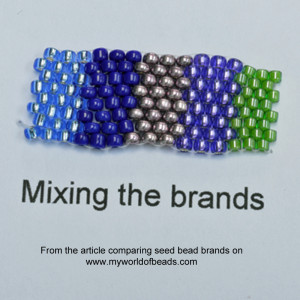
Notice how uneven the strip is. The width goes in and out as I change colour. This is what will happen to your beading project if you mix up brands. Whatever the project, whatever the stitch, the minute difference in sizes between the brands will have an impact on the finish.
In this little strip it creates unevenness. Think what it might do to a tube, or a geometric shape. Think how it might affect a project where the seed beads have been used to fill in spaces between other beads.
So, the negative impact could be a project that looks uneven and untidy. Or perhaps doesn’t sit properly (for example in a circular shape) if you have mixed your brands or used a different brand to the designer of the project.
By all means build a mix of brands within your stash. But just remember to label each tube with its brand as well as its size and colour. Then you won’t fall into the trap of using multiple brands within the same project.
Final thoughts
However, for the curious amongst you, this knowledge can bring some positive effects. I recently saw someone wearing a twisted herringbone rope that had been made mixing seed beads (I’m not sure which brand) with delicas. The very subtle difference in the sizes gave the rope a gorgeous texture.
So, if you like to design, use this knowledge to your advantage. Try mixing brands to see how the different seed bead sizes can be used to create deliberate textures or design interest.
If you are looking for beads for a particular project, then being aware of which brands are larger or smaller, can help your decision about which brand to buy.
If you are curious to learn more, then I urge you to conduct your own experiments. I would be interested to hear about the results. So, if you make an interesting discovery, do share it in the comments.
At the very least, I hope this will help you to understand that there is more difference between seed bead brands than just price.
If you have found this post helpful, then please share it with other beaders, or feel free to link to it on your own blog or website. Thank you for reading!
If you want to learn more about beading, then join my mailing list.


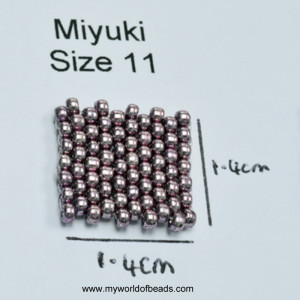
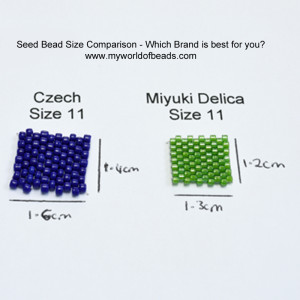
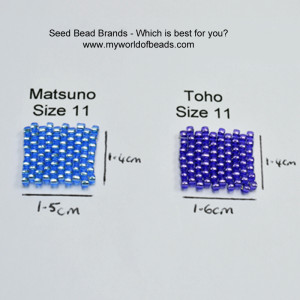



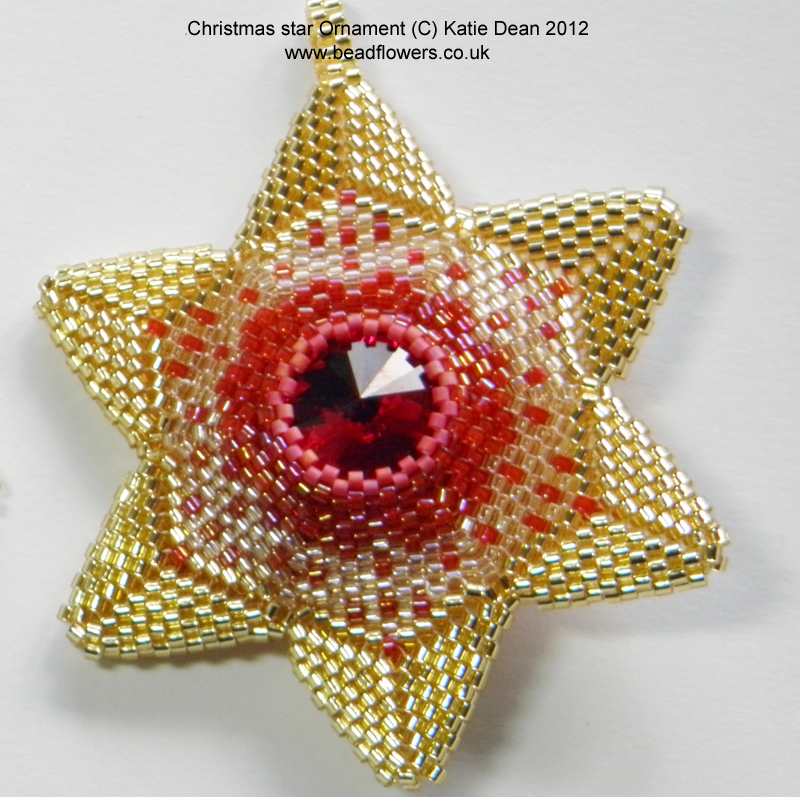






A good ‘heads up’ article Katie! I recently made a bracelet using 13/0 Charlottes and wanted to make it again in two additional colors. With the beads I had on hand there was no way the thread would pass through the beads the required number of times for the design. I’ve ordered some Toho 15’s, which are supposed to have a larger hole than other brands – need to get started on the project and check them out! Thanks for this article.
I want to mention too that there can be size variations in colors/finishes of beads from the same manufacturer. I’ve found that sometimes the permanent finish gold and silver seeds are a tad larger than others in the line.
Thanks Jeanne – that’s a good point about the colours and finishes: I too, have found that they seem to make a bit of a difference as well. It’s not much, but if you’re doing a real precision project, it can be just enough to throw everything out of a neat alignment…who knew beading could be such a challenge?!
Katie
Thanks so much! I have read some articles about the differences among brands, but your explanations give so much more information. Your illustrations really makes this clear.
I’m so glad to be able to help!
That’s really good to no wish I had read it before I started my last project as Katie no,s it was to long ,but now I no about the wavy edges as well .
I’m glad that has helped! Sorry the timing wasn’t better, but this is something I had to discover the hard way, with lots of errors along the way. Part of the joy of beading is learning something new with every new project (not just the techniques, but also making new discoveries about beads). So, that’s today’s little gem for you 🙂
Hi, I am very new to beading but have been given a nice selection by a friend. About half are either size 16 or 18 and just have “vintage” written on the outside. How can I tell the age or country of origin? I’ve seen people on several sites refer to these sizes not being made since the early 1900’s but surely the companies didn’t just drop several sizes altogether, right? Are any companies still making these sizes if I want more or a different color?
Sorry to be so long winded! I look forward to learning more about this craft.
Kelly
Not long-winded at all, Kelly! The honest answer is I don’t know how you would tell the age or country of origin. I would hazard a guess at maybe Czech for country, but I could be totally wrong there. It is still possible to get size 18/0 beads, but they’re not commonly sold. I have a few samples that came from the Old Bicycle Shop (you’ll find their website details in the beading directory under the shops). I know they were sourced from the Czech Republic. They are really tiny!!
I’ve never come across size 16, personally. Size 15 would be the more common size today. You get that size in Japanese and Czech seed beads – they’re quite widely available.
Companies can jut drop sizes (and styles) of bead. In recent years, we’ve been seeing a lot of ‘innovation’ in shapes and number of holes in beads. But the bizarre thing is, you’ll sometimes see vintage jewellery turn up with beads that look a lot like some of the ‘new’ beads of today. In fact, bead sizes and shapes can go in cycles, just as fashions in any industry. So, for whatever reason, maybe demand drops, or maybe manufacturing processes change and yes, beads can just ‘disappear’.
This is really fascinating and I’m sorry I don’t know more to help you. But if you find out anything more as you ask around, do please let me know. And, if anyone else is reading this and knows more than me, please add what you can!
Thanks for getting in touch Kelly and I hope you enjoy discovering more and more of the wonderful world of beads 🙂
Katie
Thanks, Katie!
I thought it might not be possible – no room to stamp a trade mark on something that tiny. : )
I think the size 18 is the smallest I have – I can’t imagine using the 20-24 sizes!
There are a bunch of bags labeled 3-cut but they all appear larger. Most aren’t labeled by size (yikes) so we’re having fun with the metric system at the moment.
My friend is thinking about trying French beading (flowers & small bugs) and I’m going to try adding some to my embroidery or quilting projects (Ha! I should not be looking for another hobby – but at least this one is adjacent, rather than totally different from the others).
Thanks for your comments! I’ll be around reading the blog posts – so much new info.
Kelly
You’re welcome, Kelly!
I have to say, even size 18/0 is much smaller than I would normally use. Size 11/0 is probably the most common size (could be what your 3-cut beads are?). I’ve never even seen sizes 20-24 and I suspect they would be pretty impossible to use! When you come to use your size 18 and 16, make sure you get a really fine beading needle, otherwise you’ll struggle to thread the beads.
Interestingly, French beading is how I started out – it’s a beautiful craft and a lovely way to get into beading. That typically uses size 11 beads. Your small beads will be lovely for adding to the quilting and embroidery projects. I think you will also find it quite easy to get into bead-weaving if you are already used to other hobbies that involve sewing. So, as you say, the beading will sit nicely alongside them 🙂
Have fun exploring and just ask any time you have questions.
Thanks again,
Katie